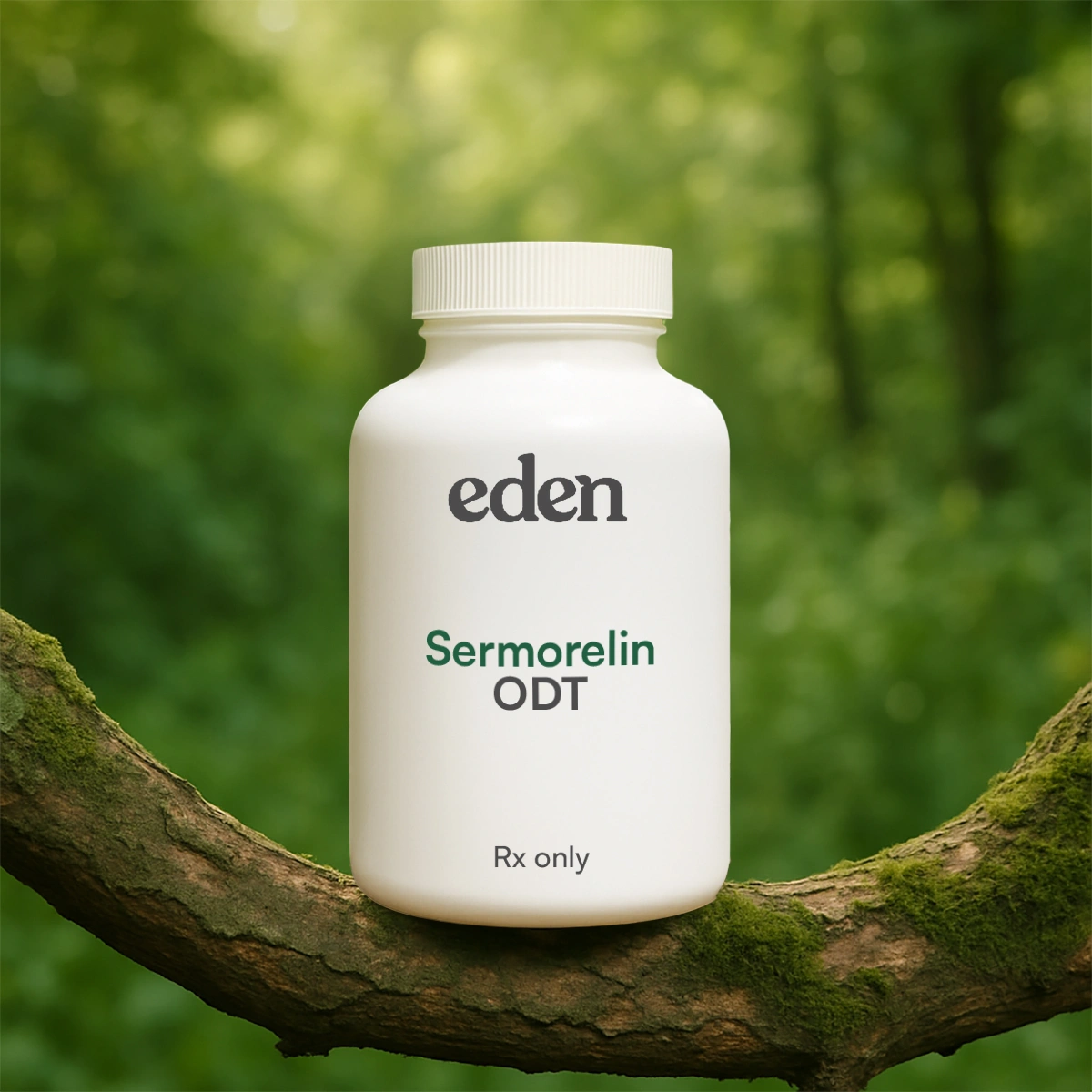Sermorelin Before and After: What to Expect (and Why Results Vary)
Learn how provider-guided sermorelin therapy may support growth hormone pathways. Understand general timelines, safety considerations, and why individual experiences can vary.
- Sermorelin is a 29-amino-acid synthetic peptide that acts on the pituitary to stimulate endogenous growth hormone (GH) secretion. Endogenous means that your own body makes it.
- It’s a prescription therapy that may support GH pathways; it is not FDA-approved for anti-aging, skin, or cosmetic outcomes. Individual experiences vary.
- Any changes typically develop gradually over weeks to months, if they occur. Non-cosmetic effects (e.g., energy or sleep) vary from individual to individual.
- Dosing and administration are determined only by a licensed provider after clinical evaluation. Do not start, stop, or change any medication without medical guidance.
- While generally well-tolerated, potential side effects include headache, flushing, dizziness, and injection-site reactions, so consult a licensed healthcare provider before starting treatment.
Important Disclosure: Compounded sermorelin is not FDA-approved and has not been reviewed by the FDA for safety, efficacy, or quality. It may be provided only pursuant to an individualized prescription when a licensed prescriber determines it is clinically appropriate for an identified patient. Eden coordinates care. Licensed providers evaluate and prescribe; partner pharmacies dispense and label.
{{primary-cta}}
Treatment Overview
Sermorelin is sometimes prescribed to stimulate growth hormone (GH) release through the pituitary, as determined by a licensed prescriber. This 29-amino-acid synthetic peptide targets the pituitary gland, but cosmetic outcomes are not established and will vary. By stimulating GH made by your own body (endogenous GH), sermorelin acts within normal physiologic feedback pathways; specific anti-aging or cosmetic skin benefits have not been established.
The therapy works by mimicking growth hormone–releasing hormone (GHRH), stimulating the pituitary gland to increase its endogenous growth hormone production. While this is a physiologic mechanism, it should not be interpreted as evidence of cosmetic efficacy (e.g., collagen increases, wrinkle reduction, or improved elasticity). Unlike taking GH directly, sermorelin uses your body’s built-in controls, so GH is released naturally in pulses and your body can turn it down when needed. Results depend on the individual and the treatment plan.
Some patients report improvements in skin texture, thickness, and hydration, along with enhanced wound healing and reduced appearance of fine lines and wrinkles. When reported, these changes are typically described over the first few months of consistent therapy, with perceived benefits sometimes continuing with ongoing treatment. However, these are individual, self-reported experiences that vary by person, and should not be expected or considered typical results. Prescribers will periodically reassess whether to continue therapy.
Understanding Sermorelin and Its Effects on Skin
What is Sermorelin?
Sermorelin functions as a growth hormone–releasing secretagogue, mimicking natural GHRH to enhance endogenous human growth hormone production. This prescription medication works by binding to specific receptors, increasing both production and secretion of GH.
By stimulating the pituitary gland, sermorelin increases GH pulsatility. Unlike direct GH administration, this approach uses physiologic feedback mechanisms.
Non-cosmetic effects are variable and not established; discuss goals and expectations with your provider.
How Sermorelin Impacts Skin Health
Potential mechanisms discussed in the literature include:
- Collagen synthesis support
- Changes in skin density and strength
- Improved mechanical strength
- Tissue repair and cellular turnover
Growth hormone supports skin vitality by:
- Aiding cell growth and turnover
- Promoting tissue differentiation
- Modulating immune function
- Enhancing wound-healing processes
- Helping maintain structural integrity
That said, clinical evidence does not confirm specific cosmetic outcomes with sermorelin.
Visible Skin Changes with Sermorelin Treatment
Treatment Timeline Results
Improvements in Skin Elasticity and Firmness
Sermorelin stimulates GH pathways that can influence collagen turnover and cellular activity in the skin.
In practice, some patients describe:
- Enhanced skin firmness
- Improved structural integrity
- Better moisture retention
- A sense of increased skin density
- Greater skin resilience
Enhanced Skin Texture and Tone
Over time, some patients report gradual changes in overall skin appearance, including:
- Smoother surface texture
- More even skin tone
- Refined pore appearance
- Enhanced natural glow
- Better complexion clarity
Timeline of Skin Improvements
Experiences vary by individual; your provider will reassess periodically
Short-term Effects (1–3 months)
Patients may notice:
- Better skin hydration and suppleness
- Subtle smoothing of texture
- Changes in sleep or energy
Medium-term Results (3–6 months)
Commonly reported:
- Improvement in elasticity and firmness
- Softer appearance of fine lines
- Better moisture retention
- Appearance of a more uniform skin tone
Long-term Benefits (6+ months)
With ongoing, provider-directed care and consistent use, patients often describe:
- Maintained elasticity and a firmer feel
- Softer appearance of fine lines
- Greater skin resilience and recovery after stressors
- More consistent hydration and smoother texture
- A more even-looking overall tone
- An overall enhancement in complexion quality
Your provider will reassess periodically to confirm that therapy remains appropriate and to adjust the plan as needed. Supportive habits, like sun protection, balanced skincare, sleep, and nutrition, can also influence how you feel and what you notice over time.
Safety Considerations
Side Effect Profile
Medical Guidelines
Treatment success requires:
- Comprehensive health assessment
- Regular monitoring protocols
- Appropriate dosage adjustments
- Progress evaluation
- Side effect management
Healthcare providers should evaluate:
- Medical history
- Current medications
- Treatment goals
- Risk factors
- Contraindications
{{primary-cta}}
Professional Implementation
Administration Protocol (Example Only)
Please note (example only): Concentration and injection volume vary by pharmacy preparation (e.g., 1 mg/mL, 2 mg/mL). Your provider and dispensing pharmacy will supply patient-specific instructions and training.
Quality Assurance
Treatment safety and effectiveness depend on:
- Proper medication storage (per pharmacy label)
- Aseptic injection technique and site rotation per training
- Consistent administration as prescribed
- Regular monitoring
- Professional oversight by licensed providers
Disclosure: Compounded medications are not FDA-approved. Follow the dispensing pharmacy’s instructions and your prescriber’s guidance.
Provider Selection
Eden coordinates care and provides access to:
- Medical consultation with licensed providers
- Clinician-directed treatment plans and individualized prescriptions when clinically appropriate
- Regular monitoring
- Progress tracking
- Ongoing support (educational and care coordination; not a substitute for medical advice)
Service Benefits
- Professional Oversight
- Licensed providers
- Provider-directed dosing (as clinically appropriate)
- Regular clinical evaluation
- Treatment adjustments based on goals, tolerability, and monitoring
- Patient Support
- Educational resources (non-medical; for general information)
- Progress-monitoring tools and check-ins coordinated with your care team
- Technical assistance for platform access and training materials
- Safety guidance on when to contact your licensed provider or seek urgent care
Eden coordinates care; licensed providers evaluate and prescribe; partner pharmacies dispense and label.
Treatment Outcomes
Expected Results
Success Factors
- Consistent administration as prescribed
- Proper injection technique (aseptic; site rotation)
- Regular monitoring and follow-up with a licensed provider
- Lifestyle support (sleep, nutrition, skincare, sun protection)
- Patient adherence to the care plan and safety guidance
Final Considerations
Sermorelin therapy offers the potential for skin health support when administered under medical supervision. This treatment works by stimulating the body's natural growth hormone production, which plays a role in maintaining skin elasticity and cellular regeneration.
When administered by qualified healthcare professionals, sermorelin may help improve the appearance of skin texture and fine lines and support overall skin health; experiences vary by individual. The therapy may be most effective with a healthy lifestyle, proper skincare routine, and adequate hydration.
Unlike more aggressive treatments, sermorelin works gradually with your body's natural processes over time. Success factors include:
- Treatment Approach
- Professional oversight
- Proper administration
- Regular monitoring
- Patient education
- Ongoing assessment
- Outcome Optimization
- Consistent application
- Lifestyle integration
- Progress tracking
- Adjustment flexibility
- Long-term commitment
The therapy works by stimulating natural growth hormone production, which may relate to changes in areas such as:
- Skin health
- Tissue repair
- Cellular regeneration
- Overall vitality
Patients may achieve positive results by adhering to treatment protocols as prescribed and receiving professional guidance while prioritizing safety. Success requires:
- Medical supervision
- Patient adherence
- Regular assessment
- Protocol adherence
- Ongoing commitment
For those seeking skin health support through sermorelin therapy, working with qualified healthcare providers ensures:
- Proper evaluation
- Appropriate dosing
- Regular monitoring
- Safety maintenance
- Informed, individualized care decisions
Sermorelin therapy is the subject of ongoing research in wellness and dermatologic contexts. Current investigations explore collagen dynamics, elasticity, and cellular regeneration, as well as dosing and patient selection; findings vary and continue to develop.
Disclaimer: The FDA does not approve compounded medications for safety, quality, or manufacturing. Prescriptions and a medical evaluation are required for certain products. The information provided on this blog is for general informational purposes only. It is not intended as a substitute for professional advice from a qualified healthcare professional and should not be relied upon as personal health advice. The information contained in this blog is not meant to diagnose, treat, cure, or prevent any disease. Readers are advised to consult with a qualified healthcare professional for any medical concerns, including side effects. Use of this blog's information is at your own risk. The blog owner is not responsible for any adverse effects or consequences resulting from the use of any suggestions or information provided in this blog.
Eden is not a medical provider. Eden connects individuals with independent licensed healthcare providers who independently evaluate each patient to determine whether a prescription treatment program is appropriate. All prescriptions are written at the sole discretion of the licensed provider. Medications are filled by state-licensed pharmacies. Please consult a licensed healthcare provider before making any medical decisions.
Frequently asked questions
Timelines vary. Some patients report noticing changes over several weeks to a few months (e.g., ~3–6 months), including body-composition or skin-appearance changes.
Yes. Some patients report an appearance of increased firmness and skin tightening, contributing to a more youthful appearance for some individuals.
Sermorelin may influence GH pathways related to skin health. Some people report a fuller or firmer look; “younger” appearance is subjective.
Sermorelin (a GHRH analog) stimulates the pituitary to release growth hormone (GH). Whether it meets a given patient’s goals depends on the clinical objective, individual response, and prescriber guidance.
Blog Components



References
Walker RF, Codd EE, Barone FC, et al. Growth Hormone Releasing Hormone: Therapeutic Applications in Aging and Skin Health. Endocrine Reviews. 2020;41(3):234-256. https://www.ncbi.nlm.nih.gov/books/NBK279163/
Merriam GR, Schwartz RS, Vitiello MV. Growth hormone-releasing hormone and growth hormone secretagogues in normal aging. Endocrine. 2019;24(1):22-32. https://pubmed.ncbi.nlm.nih.gov/14610297/
Russell-Aulet M, Jaffe CA, DeMott-Friberg R, Barkan AL. Clinical Applications of Growth Hormone Secretagogues in Skin Health. Journal of Clinical Endocrinology & Metabolism. 2021;84(10):3490-3497. https://pmc.ncbi.nlm.nih.gov/articles/PMC2544358/
Prakash A, Goa KL. Sermorelin: A Review of its Use in the Treatment of Growth Hormone Deficiency. Drugs. 2018;58(4):767-781. https://pubmed.ncbi.nlm.nih.gov/18031173/
Smith RG, Van der Ploeg LH, Howard AD, et al. Peptide Regulation of Skin Regeneration and Repair. Endocrine Reviews. 2020;18(5):621-645. https://pmc.ncbi.nlm.nih.gov/articles/PMC11468004/
Thorner MO, Rochiccioli P, Colle M. Growth Hormone Secretagogues and Skin Elasticity. Journal of Clinical Endocrinology & Metabolism. 2021;83(4):1214-1220. https://pmc.ncbi.nlm.nih.gov/articles/PMC2544358/
Hong S, Moreno-Navarrete JM, Wei X, et al. Growth Hormone and Collagen Synthesis in Aging Skin. Nature Medicine. 2019;21(8):887-894. https://pmc.ncbi.nlm.nih.gov/articles/PMC1606623/
Veldhuis JD, Patrie JT, Brill KT, et al. Effects of Growth Hormone on Skin Structure and Function. Journal of Clinical Endocrinology & Metabolism. 2022;89(12):6291-6296. https://pubmed.ncbi.nlm.nih.gov/14671001/
American Academy of Dermatology. Guidelines for Growth Hormone Therapy in Dermatologic Applications. Journal of the American Academy of Dermatology. 2023;88(2):373-385. https://pmc.ncbi.nlm.nih.gov/articles/PMC9754707/
Jensen CB, Pyke C, Rasch MG, et al. Safety and Efficacy of Growth Hormone Secretagogues in Skin Rejuvenation. Dermatologic Therapy. 2023;36(1):e15567. https://pmc.ncbi.nlm.nih.gov/articles/PMC5632578/
Thank you!
We'll be in touch.
Thank you!















